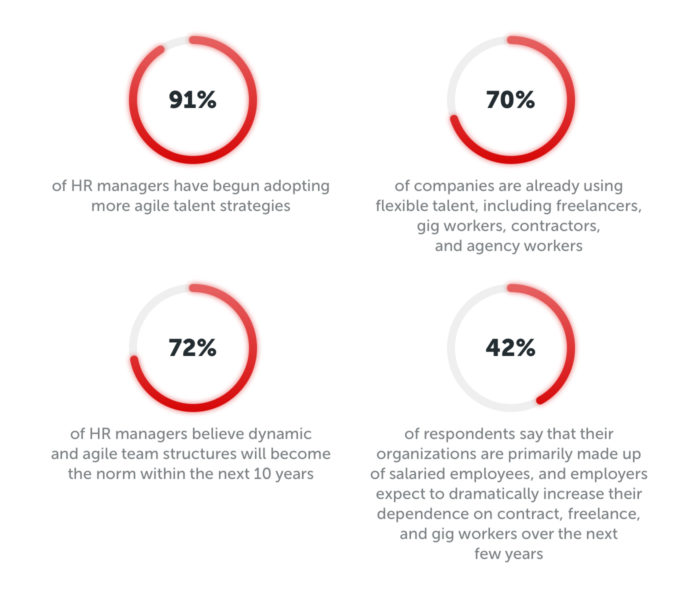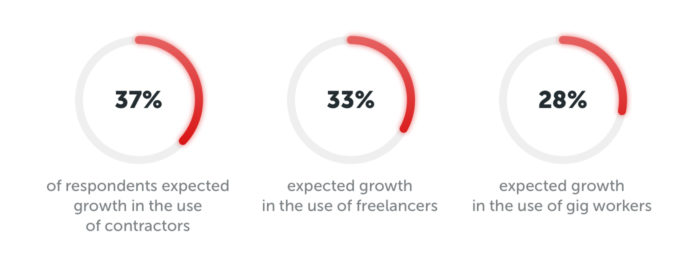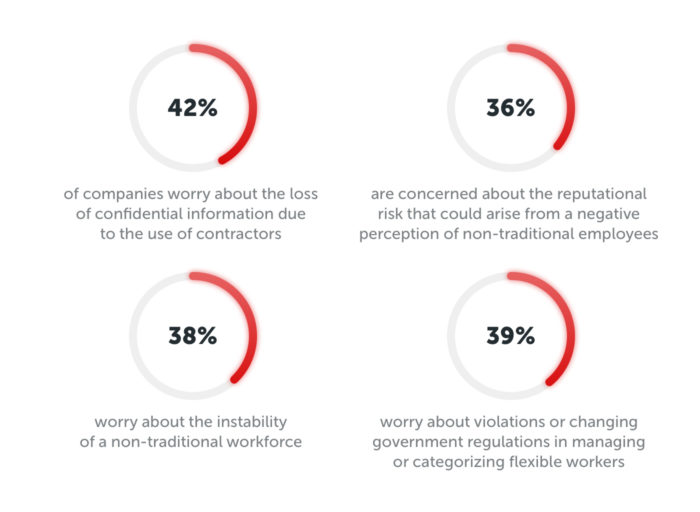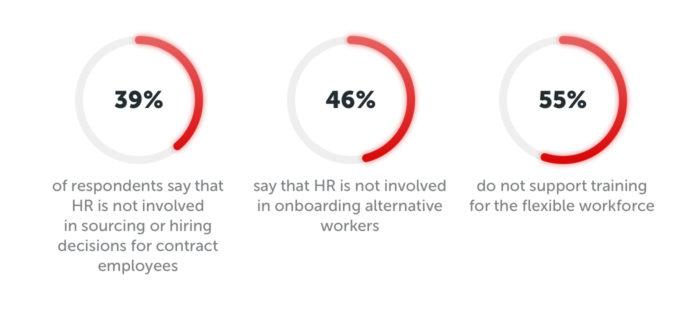Distributor Sales Enablement: 5 Pitfalls Holding Your Field Back
Flexible Talent: Apply Gig Economy Principles to Your Full-Time Employees
With low unemployment levels and a tight labor market, a lot of companies feel the pressure to find the right talent to get work done. In the world of constant technological disruptions, the shrinking half-life of skills, emerging and fluid job roles, and the upcoming 2030 workforce crisis, there’s a need for innovative thinking at all levels: from recruiting strategies to talent management and development.
The 2018 Future Workforce Report by Upwork shows that agile team models will change the workforce in the next 10 years with 52% of hiring managers stating that talent shortages drive the adoption of a flexible workforce model. In fact, they foresee a 168% increase in the amount of work done by flexible talent by 2028.
So let’s go into details of this new way of sourcing talent.
Flexible talent: a new strategy for talent-proofing your company
Talent shortages aggregated by the demand for more specialized skills made three times as many HR managers face difficulties in recruiting employees in the past year. This situation resulted in embracing a more dynamic workforce ecosystem—a flexible one.

Data from the 2018 Global Human Capital Trends by Deloitte and The 2018 Future Workforce HR Report by Upwork.
This tendency to resort to on-demand workforce services is explained by the advantages companies get besides closing the talent gap. The Gig Economy facilitates finding the right skills at the right time without any geographical limitations. Moreover, you can make your business work 24/7 with overseas gig workers in different time zones. By working with freelancers, companies can save up to 30% annually since they don’t have to spend money on physical space in the office, equipment, and other on-site resources. Most importantly, there’s better agility in terms of scaling the workforce upward or downward depending on changes in the business.
All the above-mentioned benefits are responsible for more than 40% of workers who are now employed in “alternative work arrangements” in the United States.
Following the idea of the flexible workforce ecosystem, PwC, for example, launched the Flexible Talent Network that allows the company to resort to on-demand professionals on a recurring basis across all areas, depending on its business needs.
“People assume that to work at a big firm they need to follow traditional working patterns–we want to make it clear that this isn’t the case. In order to recruit the best people, we recognize that we need to offer greater flexibility, different working options, and a route back in for those looking to restart their careers,” explains Laura Hinton, chief people officer at PwC.
PwC’s opportunity allows people to offer their skills for hire without working traditional hours, taking into account candidates’ preferences and matching them to suitable roles.
The pitfalls of a flexible talent strategy
In spite of all advantages a flexible talent strategy has to offer, there are some pitfalls that keep a lot of companies from embracing it to the fullest extent.
1. The absence of a set of policies to manage a variety of flexible workforce types
According to Deloitte findings, when companies were asked to forecast the makeup of their workforce in 2020, they gave the following answers:

The workforce ecosystem: Managing beyond the enterprise.—Deloitte
Despite increasing demand for flexible talent, only 16% of companies had an established set of policies and practices to manage a variety of worker types. This triggers serious concerns about the readiness of companies to embrace the upcoming changes.
2. Reasonable fears of working with flexible talent
Regardless of the expected growth in the use of an agile workforce ecosystem, companies expressed worries towards this strategy.

The workforce ecosystem: Managing beyond the enterprise.—Deloitte
3. A low level of HR involvement
HR is still not that good at helping companies manage a flexible workforce.

The workforce ecosystem: Managing beyond the enterprise.—Deloitte
It’s difficult to find the fine line between full-time employees and flexible ones. For instance, how should companies screen and assess the flexible workforce’s skills? What’s the best way to onboard newly hired gig workers? How should they plug contractors into local teams for better collaboration? And how can they engage them in continuous learning to retain the best talent?
How to start implementing a flexible talent strategy in 2019
If the above-mentioned pitfalls of embracing a flexible talent strategy raise a red flag or temporarily “fixing a leaking roof” with gig workers is not an option for you, then you should look closely at your greatest source of talent—your current employees.
Turn your employees into “in-house freelancers”
Sounds controversial? Well, let’s see why this strategy is necessary to engage and retain your existing workforce and to combat talent shortages.
First of all, 78% of HR managers believe that skills are going to become extremely specialized, so reskilling will be a must in the years to come. You don’t want to look for gig workers for every skill required, do you? However, reskilling your employees lets them develop professionally (while also showing that you care about them, winning their loyalty) and protects your business from disruptions. A smart learning platform can help you deliver personalized, ongoing training to your employees by tapping into their performance data and your business needs. This way, you remain confident that your people are equipped with the latest knowledge and skills that cover most talent shortages and reduce skills mismatch.
Secondly, internal recruitment is a good way to bypass costs connected with hiring new people, their onboarding and familiarization with various company-specific details. Deloitte reveals that even though most companies spend only 6% of their recruitment budgets on internal candidates, these candidates fill 14% of job openings. Moreover, three out of four leading talent acquisition teams resort to internal talent pools.
Think of it this way: your existing employees have proven accomplishments and prescreened skill sets; they are well aware of your company’s vision, objectives, and they’re a good cultural fit. You’re interested in retaining them since you know the real costs of losing a valuable employee. So all it takes is to make them lifelong learners to guarantee your safety from talent-sourcing issues and ensure that you know your learners’ needs. This can be done through the building of personalized learning paths tied to employees’ career goals, performance data, your company’s anticipated skills needed, business goals and the like.
Minnesota’s Mayo Clinic is a good example of embracing a lifelong learning culture and practicing internal recruitment. The clinic encourages employees to build career paths under the influence of exploration and growth. Thanks to these practices, turnover in the organization is one of the lowest in the industry, and professionals with 30-year tenures can boast of having held multiple jobs within the same company.
If you want to build a lifelong learning culture in the workplace and timely upgrade critical skills to talent-proof your company, ask us for a demo to see how Rallyware can help you out!
News and Insights on Workforce Training & Engagement
We’re among top-notch eLearning and business engagement platforms recognized for effective training and talent development, helping to empower distributed workforces
Subscribe
